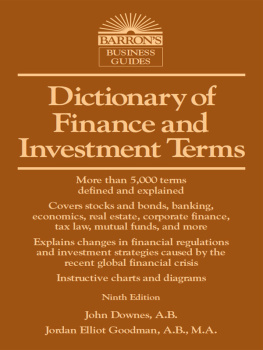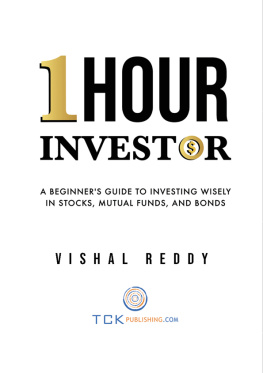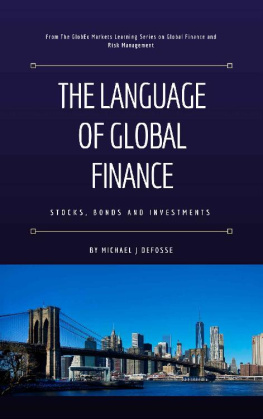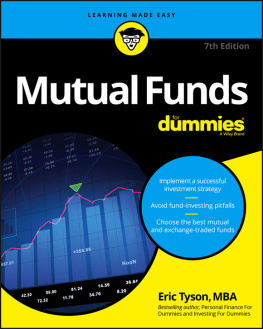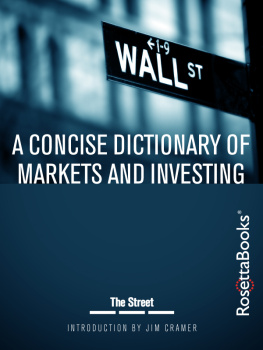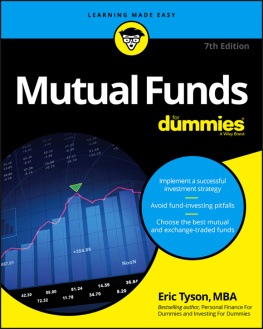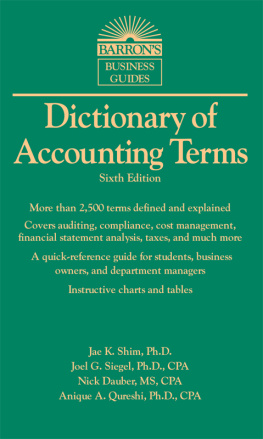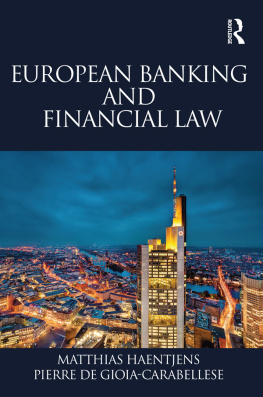
Dictionary of
Finance and
Investment Terms
Ninth Edition
John Downes, A.B.
Coauthor, Beating the Dow
Freelance Financial Writer
Former Vice President, AVCO Financial Services, Inc.
City of New York, Office of the Mayor, Office for Economic Development
Jordan Elliot Goodman, A.B., M.A.
Author, Master Your Debt
Author, Fast Profits in Hard Times
Author, Master Your Money Type
Author, Everyones Money Book
Host, Money Answers Show on Voice America Business Network
Creator of Moneyanswers.com Web site
Former Financial Commentator, Marketplace Morning Report
Former Wall Street Correspondent, MONEY Magazine , Time Warner Inc.
Former Financial Commentator, NBC News at Sunrise
Frequent Guest Commentator on radio and TV shows across America

Copyright 2014, 2010, 2006, 2003, 1998, 1995, 1991, 1987, 1985 by Barrons Educational Series, Inc.
All rights reserved.
No part of this publication may be reproduced or distributed in any form or by any means without the written permission of the copyright owner.
Barrons books are available at special quantity discounts to use as premiums and sales promotions, or for use in corporate training programs. For more information, please write to the Special Sales Manager, Barrons Educational Series, Inc. at the mailing address indicated below.
All inquiries should be addressed to:
Barrons Educational Series, Inc.
250 Wireless Boulevard
Hauppauge, NY 11788
www.barronseduc.com
eISBN: 978-1-4380-9254-6
Please be advised that certain pages, illustrations, tables, graphs, etc. may look different depending on what type of device you are using to view this eBook on. Please adjust your device accordingly.
CONTENTS
The previously issued Eighth Edition covered the first two years following the financial meltdown of 2008. Emergency measures in the form of bailouts and monetary stimulus had avoided a total collapse of the world economy. But the worst recession since the Great Depression of the 1930s was in effect, unemployment was perilously high, and real estate values from coast to coast had fallen well below related mortgage debt, leaving millions of families facing foreclosure. The national debt was at a staggering level of over $10 trillion, annual budget deficits were running over $1 trillion, and economic growth was barely positive. But early signs of recovery were beginning to emerge, termed green shoots by a financial establishment ever eager, whatever its mood, to embellish the argot of finance and investment.
This Ninth Edition defines the many new terms that resulted from the developments since the Financial Crisis of 20082009. The critical tension between the administration and a Congress divided in multiple ways has produced a stalemate, despite efforts like the Simpson-Bowles Commission to formulate reasonable compromises. Major programs, such as Obamacare and the Big Three entitlement programs, are targets of deficit hawks willing to hold routine debt ceiling approvals hostage to debt reduction demands, threatening a potentially catastrophic government default on bond obligations and prevented only by congressional measures that buy a few months of time. For its part, the Federal Reserve under Ben Bernanke and now his successor, Janet Yellen, has resourcefully used the central bank to keep interest rates historically low to stimulate economic growth through home buying and business investment. Some of the most impressive accomplishments have been in legislative areas concerned with consumer protection, bank regulation, modernization of securities exchanges, help for homeowners under water, and tax laws.
The United States economy has been through a period of transformative if sometimes unseemly debate about a future that has to be radically different from its recent past because nothing less than long-term economic survival is at stake. The stock market may be breaking records reflecting greater corporate profits thanks, among other things, to reduced labor costs and the spread of new technologies. But there is a distressing lack of socio-economic balance. 1% of the population looks out the windows of too-big-to-fail institutions to see activists from the other 99% conducting Occupy Wall Street demonstrations. Knocking at the doors of the financial behemoths, meanwhile, investigators from the Securities and Exchange Commission and other agencies have imposed massive penalties on banks that used government-insured deposits to finance massive trades in worthless mortgages. Reform is taking its time, but it is underway and momentum is gathering.
The Prefaces to previous editions are summarized below, providing an historical narrative of events that marked the financial worlds journey to near systemic collapse in 2008. Also highlighted are the major developments in the politically challenging process currently underway of mending our ways.
The First Edition , published in 1984, noted that the previous two decades had seen more fundamental changes in finance and investment than any similar period since the Great Depression, which had ushered in massive reforms in the economy and securities markets. Since 1970, deregulation, major tax law revisions, globalization of markets, giant corporate mergers, and, above all, the widespread use of computer and advanced communications technology had altered the world of finance and investments in ways affecting everybody.
Before 1970, investors were typically wealthy people who bought stocks for income and switched to bonds when interest rates exceeded dividends and prospective growth. By the 1970s, mutual funds and other institutional investors became dominant. Acting on behalf of average people, they invested for total returns, capital gains plus interest in the case of bonds. Competition for returns forced a short-term investment focus, assuring volatility. In an effort to reduce, or at least redistribute, risk, computer technology was used to create a new array of hybrid investments and derivative products. Complex and bewildering investment choices spawned an expanded establishment of investment professionals specializing in different aspects of the problem and having varying credentials.
The gathering trends of deregulation, globalization, and computerization had a traumatic economic and political backdrop. The Middle East oil embargo in the early 1970s caused skyrocketing oil prices, leading to a combination of runaway inflation and economic stagnation called stagflation. The years 197374 witnessed the worst bear market since 1929. By the early 1980s, inflation had peaked at over 14 percent, the bank prime lending rate had reached a stratospheric 21.5 percent, the economy was in recession, and the Dow Jones Industrial Average, sustained by a group of all-weather institutional favorites known as the Nifty Fifty, was hovering around 1,000, about where it had been ten years before.
Thus began the Roaring 80s and Reaganomics, marked by controlled but historically high interest rates aimed at ending inflation, by record-setting federal deficits, and by the onset of the longest period of sustained economic growth and stock market gains in American history. Corporate takeovers financed by junk bonds and newly deregulated savings and loan institutions diversifying into speculative real estate investments were, by the mid-1980s, setting the stage for calamity. The Second Edition , published in 1987, took account of these developments while noting such landmark new developments as Londons Big Bang in 1986 and the historic Tax Reform Act of 1986, which eliminated a confounding maze of tax loopholes and shelters and made economic merit rather than tax advantages the primary criterion for investment decision making.
Next page
